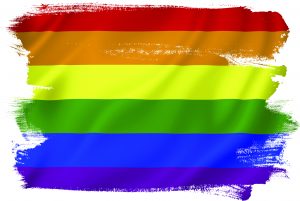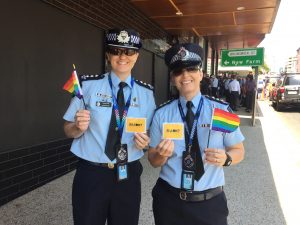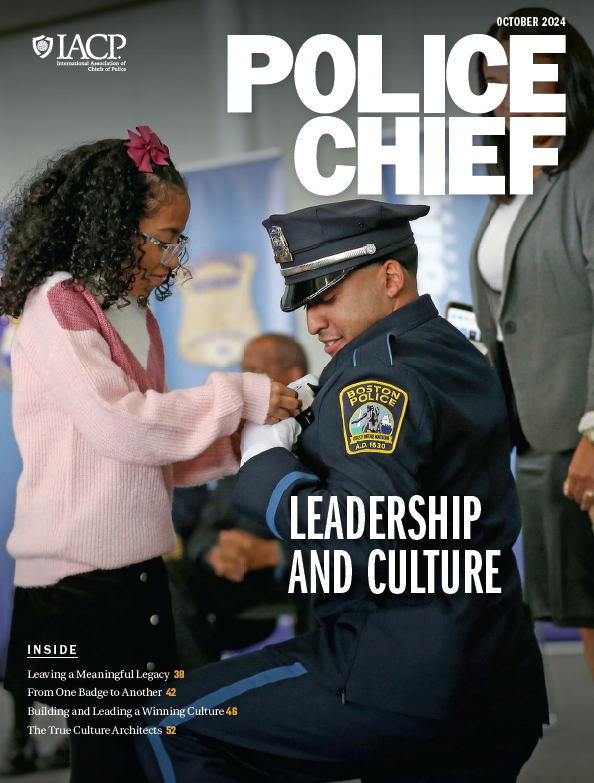Fifty years ago marked the Stonewall Riots—the flashpoint over the historic conflicts between the police in New York City and its LGBTQ community that, for generations, endured selective enforcement by government officials.
Following World War II, some government and religious leaders became increasingly alarmed that LGBTQ individuals and businesses had ceased operating in obscurity and became more “visible” by moving gay cabarets above ground. These entities perceived this phenomenon as a direct violation of society’s conservative views on morality that had remained virtually unchanged since the Victorian era. Ultimately, the police were often used to control political concerns.
During that time, the mechanism used by some law enforcement agencies for “dealing” with homosexuals consisted of increased targeting of gay-owned bars and by extending the customary “pay-offs” that select officers routinely demanded from nearly every establishment.
The residual fear instilled within the U.S. LGBTQ communities based on these and other oppressive actions directly impacts the community’s perception of how truly accepting law enforcement is of LGBTQ issues, including in its outreach efforts and hiring practices. Though many improvements have been made regarding law enforcement relations with their respective LGBTQ communities, these historic memories and suspicions continue to exist, particularly regarding how police agencies accept (or don’t accept) LGBTQ individuals within their ranks. These ongoing perceptions create significant challenges for recruiting, hiring, or retaining law enforcement officers who may identify as LGBTQ. These same concerns further impact closeted LGBTQ law enforcement employees who remain unsure or unsettled on how their employers, supervisors, and coworkers feel about their sexual orientation or gender identity. These fears do not lend themselves to fostering a healthy work environment and may result in an agency never appealing to a large group of highly qualified potential employees, losing the good LGBTQ employees they already have, or defending against costly litigation as a result of inappropriate behavior involving the public, coworkers, or management.
Perceptions
For some law enforcement officials reading this article, this history and the author’s experiences may seem absurd by today’s hiring and professional standards. Rest assured, this was the reality of the past. Unfortunately, the past in many people’s minds is never that far away from the present, especially if they see no evidence to support that anything has really changed for the better within policing institutions. As one of the United States’ only full-time LGBTQ police liaisons, the author spent a significant amount of time during his policing career traveling around the United States, Canada, and Europe, talking to police executives about the challenges they face with working productively with their respective LGBTQ communities and employees.
Many of the chiefs and sheriffs readily admitted they don’t know much about LGBTQ issues and ask for additional assistance and training on this topic. One revelation made from an executive was “I want to let my LGBTQ community know I care, but I don’t want to screw it up and offend them.” Many other law enforcement leaders have relayed the same concerns; however, police executives who adopt the mantra “If I don’t try, I can’t fail” are doomed in their attempts to regain the trust with some within their LGBTQ communities. That said, it is also critically important for LGBTQ activists to understand they need to step back and let the police navigate their way through uncharted social territory, helping them if needed, and waiting before automatically condemning their efforts.
LGBTG Employees
As a former full-time police liaison and a consultant who specializes in enhancing relationships between law enforcement and LGBTQ communities, the author receives a multitude of inquiries from police executives regarding how to better connect with their LGBTQ employees and community members. Their concerns clearly demonstrate that, although much has changed within the profession, many things have not. This is especially evident regarding policies, internal interactions with coworkers, and employees’ confidence in their organizations’ abilities to navigate the organizations’ way through sensitive LGBTQ social topics and personnel issues that have never been addressed.
The author has made concerted efforts to meet with LGBTQ law enforcement officers throughout the United States, including both those. who serve openly and those who do not. The purpose is to make objective comparisons between the level of acceptance that LGBTQ individuals have experienced in the policing profession over the past 40 years. Obviously, every agency is different depending on its size, geographic location, leadership, and community acceptance; however, several factors were consistent with those who participated in these interviews.
“All it takes is a sincere commitment, internally and externally, to prove to the public that the modern culture within the policing profession is changing in a direction that all members can be proud of. ”
When asked how they felt regarding their perception of acceptance in their respective agencies, the majority of these officers responded by saying, “Everything’s fine; we just don’t talk about it.” These comments are especially concerning because they reflect the same attitudes that existed in the 1970s and 80s. Another obvious dynamic that occurred during these interviews was that the veteran lesbian officers in 2019, who had been serving “openly” for decades, clearly outnumbered their male counterparts, whose comfort level in serving openly or discussing their sexual orientation, ranged from caution to paranoia.
The officers and supervisors interviewed offered personal stories regarding their experiences in either being “outed” or voluntarily disclosing their sexual orientation to their coworkers. There was also general consensus with most that their discussing socially sensitive topics at work, especially LGBTQ-related issues, could be met with ridicule from their peers, lack of promotional opportunities, transfers, or termination. Their reluctance was not necessarily based on actual events (although some were), but rather the perception that these situations may occur, combined with their ongoing uncertainty on how their command staff or executives would react.
The male LGBTQ officers who served openly, as well as those who did not, revealed that their situation differs from that of their lesbian counterparts. Their reluctance in “coming out” was based on the hyper-masculine banter that is prevalent in any police organization and their hesitation or fear that speaking openly about their boyfriend or husband in a roll call or a squad party would cause an undesirable reaction with their straight male peers. The male officers’ skepticism about whether their administration’s rhetoric would match up with the reality when addressing workplace LGBTQ harassment was also of concern and caused many of them to remain in the closet and serve out their careers in silence.
The discomfort in “coming out” is not just limited to officers and first-line supervisors. Many police commanders including sheriffs and chiefs feel equally unsure about revealing their sexual orientation, especially in conservative regions of the United States. Although such concerns may be based on speculation, these individuals calculate that the risks may outweigh the benefits of revealing their personal information and thus choose to remain silent. If this dynamic continues to exist internally within the law enforcement profession, imagine how difficult it will be to convince the public, with any degree of believability, that the law enforcement culture has really changed enough to alleviate concerns regarding diversity and acceptance.
Hiring Challenges
These internal organizational challenges, combined with media coverage of individual acts of misconduct by some law enforcement officers toward the LGBTQ community, serve as a constant reminder to LGBTQ community members and the rest of the public that declarations by some police officials touting their progressive policies toward diversity may be nothing more than deflective sound bites. These suspicions continually erode the public’s confidence regarding law enforcement’s professionalism and objectivity toward LGBTQ individuals. Many agencies have made significant efforts toward building positive relationships with their LGBTQ communities and are engaged in productive efforts to address sensitive personnel issues designed to make their employees feel valued and accepted. However, based on interviews with many closeted LGBTQ law enforcement employees, a significant amount of work remains to be done.

The appearance of historic apathy toward employee wellness in law enforcement often resonates throughout the LGBTQ community and its view toward police. More importantly, this perception simultaneously restricts law enforcement’s ability to attract and retain potential police officer candidates who identify as LGBTQ. In an era where law enforcement is struggling to find enough qualified individuals to fill its ranks, indirectly alienating LGBTQ applicants has always been a significant concern that many law enforcement executives readily admit they feel helpless in addressing. The term “alienation” regarding law enforcement’s ability to attract qualified minority candidates can have a variety of definitions, one of which can be described as an overt impression that law enforcement agencies may still resist hiring LGBTQ employees, due to apparent apathy regarding LGBTQ issues or no evidence to counteract the impression that nothing is being done.
As all officers eventually realize during their time in the law enforcement profession, realities do not always match up with perceptions in regard to the public’s understanding of modern police hiring practices and cultural acceptance of minority applicants within law enforcement agencies. This is especially true with applicants, officers, and civilian employees who identify as LGBTQ. Police executives must recognize that if they have not clearly established and updated internal and external policies regarding their employees’ conduct toward each other and members of the public, they cannot realistically expect anyone outside the agency to believe they would be considerate of this topic.
Younger LGBTQ job seekers of today have a multitude of choices on which professions to pursue. In the age of the internet, it is very easy for potential police applicants to negotiate their way through modern websites and identify organizations in the private or public sector that may be attractive to them. Unlike previous generations where a duty to government service, job security, and pensions were highly important, many of the LGBTQ job applicants of today are far more concerned about how they will be accepted in the workforce. Many of these applicants will automatically assume a law enforcement agency may not be LGBTQ friendly based on historical incidents and the fact that most agencies make very little effort, if any, to promote the impression of LGBTQ acceptance.
For those agencies that do make mention of their diversity awareness, including with the LGBTQ community, the proof lies with how many officers serve openly in their respective jurisdictions. Statistically speaking, it would appear evident that the larger a law enforcement organization is, the more LGBTQ employees it should have. Even if this is true, many of those officers are not comfortable enough to expose their sexual orientation or gender identity to their administration, supervisors, or peers without fear of reprisal. Regardless of what an agency’s mission statement says regarding diversity, if it simply exists on paper with no substance or real-life examples for employees to reference, it means virtually nothing and will be met with ongoing skepticism.
 The LGBTQ police applicants of today have the ability to find information about any law enforcement organization in the world through agency websites, media stories, or social media postings. The information garnered by potential LGBTQ police applicants can reveal a variety of telltale signs, including positive or negative coverage on issues important to them. If an agency has a long history of diverse practices, domestic partnership policies, transgender-friendly HR protocol, LGBTQ training for employees, and generally broad LGBTQ community support, it will likely draw a broader applicant pool of LGBTQ candidates.
The LGBTQ police applicants of today have the ability to find information about any law enforcement organization in the world through agency websites, media stories, or social media postings. The information garnered by potential LGBTQ police applicants can reveal a variety of telltale signs, including positive or negative coverage on issues important to them. If an agency has a long history of diverse practices, domestic partnership policies, transgender-friendly HR protocol, LGBTQ training for employees, and generally broad LGBTQ community support, it will likely draw a broader applicant pool of LGBTQ candidates.
However, many law enforcement executives fall short in the above categories. The majority of these agencies’ command structures, regardless of size, don’t think much about LGBTQ issues, especially involving their current and potential employees. The reasons for this vary and include the fact that law enforcement executives often recognize a need to focus on these social topics because they are unaware that they have any LGBTQ employees and are thus unaware of any problems that may exist. Other reasons include the fact that some police executives often have anxiety regarding addressing LGBTQ topics, out of fear they don’t know much about LGBTQ issues; feel awkward discussing them, are afraid of infringing on their employees’ personal lives; or are concerned about political pushback from activist groups that may criticize any efforts made by police. At best, not addressing these topics implies to some employees that their administration doesn’t care enough to talk about LGBTQ-related issues. At worst, it implies that their leadership is not supportive. In either case, the lack of conversation regarding LGBTQ acceptance hinders the law enforcement culture from progressing and has a negative impact on attracting qualified LGBTQ applicants to those agencies. For those law enforcement agencies that care enough about these issues to take a firm, proactive public stance on this topic, their burden is lessened because they have already established credibility within the LGBTQ community they serve.
Effective LBGTQ Training
When it comes to productive interactions with their LGBTQ community, the author’s advice to police executives is simple: Don’t wait for a crisis to repair the damage. Doing so is costly, usually unsustainable, and often met with community suspicion, and it leaves the agency vulnerable to ridicule. Furthermore, crisis-driven damage control often opens the door to ineffective solutions or mandates by outside entities—many of which have varying agendas that often make things worse.
Choosing the right instructor is crucial to educating employees on LGBTQ topics. Over 20 years ago, the Seattle Police Department mandated diversity training for all employees. The training instructors were brought in from political organizations, likely at the request of city officials, to educate law enforcement officers on diversity. The officers in the room watched the instructor take to the podium and begin a slow-burning tirade against the police. She successfully alienated everyone in the room within the first hour. Although the diversity message was good, the person presenting it was ineffective, divisive, and agenda driven. The agency undoubtedly spent considerable funding on this training, only to have it collapse before it began. It was an opportunity lost and left the intended audience reluctant to participate in any future training of this type.

The point of this example is that having training on sensitive topics, especially LGBTQ-police relations can have a multitude of outcomes that range from highly productive to disastrous. Some of the audience members in police training sessions are LGBTQ officers who will listen intently to not only the training content and instructor’s dialogue, but also, more importantly, to the comments from their peers and supervisors. It usually becomes quite clear to all involved whether the training and the agency’s commitment to change its culture through this training is either sincere or simply just another bureaucratic exercise in “checking the box.” If the motivation for such training is the latter, it almost guarantees that the potential for a covert or overt hostile work environment experienced by some LGBTQ officers will continue to keep them from serving openly in their respective agencies.
The Solution Is Yours
Finding solutions to making LGBTQ applicants, officers, supervisors, and employees feel comfortable in an organization is the responsibility of everyone, but it falls on the shoulders of the agency executive to change a historically entrenched culture. Many police chiefs and sheriffs are beginning to make significant efforts to adopt modern methods and policies regarding employee wellness and recognizing that by not doing so can be detrimental to their organizations.
With the suicide rate among law enforcement officers climbing in the United States over recent years, imagine the additional potential impact on LGBTQ officers, who not only experience the traditional stressors of modern policing, but the internal anxiety of not feeling accepted by their own profession. Many younger police applicants, employees, and officers, especially those in progressive population hubs, face far less internal scrutiny than those in previous generations. However, many more continue to evaluate if it’s even worth the effort of applying to become a law enforcement officer because they remain unsure of the true culture regarding LGBTQ issues within today’s law enforcement organizations.
These challenges do not exist only from the lack of awareness or efforts by executives to educate the public on the significant changes within the law enforcement culture pertaining to LGBTQ-police relations and diversity within their respective organizations. The ongoing social media rhetoric regarding perceptions that some activists share with uneducated viewers leaves law enforcement helpless to tout their diversity efforts because there are no efforts to defend. This reactive methodology leaves the agency defenseless against anti-police stereotypes regarding diversity within its ranks and the community in general.
It doesn’t take a significant portion of a budget or staffing to demonstrate an agency’s awareness and support of its LGBTQ community. A police leader’s proactive efforts in addressing some of these sensitive topics can pay positive dividends that will allow the term “diversity” to be more than just a word. All it takes is a sincere commitment, internally and externally, to prove to the public that the modern culture within the policing profession is changing in a direction that all members can be proud of. In general, U.S. LGBTQ communities are very supportive of law enforcement—all they really need is proof to demonstrate that you care.
Police leaders hold the key to accomplishing that mission. d
Please cite as
Jim Ritter, “Serving in Silence: The Quest for LGBTQ Acceptance Within Law Enforcement,” Police Chief Online, August 11, 2021.



